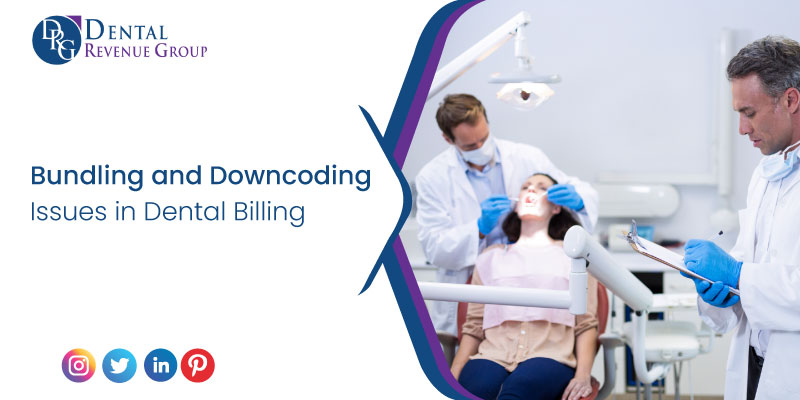The practice of coding has been developed to standardize the reporting of dentist services. Dental billing is an efficient and cost-effective method for collecting all the necessary information for payment processing by third-party payers and insurers. In dental billing, there are different issues like bundling as well as down coding. Dental practices must take care of down coding and bundling in order to avoid these issues, which occur in every medical office.
Breakdown Of Bundling And Downcoding
Payer-down coding and payment bundling are two of the most malicious practices associated with dental claim reimbursement. This resulted in a negative bottom line and derailed income cycle, which you do not want. It is critical for all healthcare facilities, not only dental, to understand the distinctions between procedure bundling and down coding. If you can’t differentiate, it’s time to engage a professional dental billing and coding company to explain the complexities of down coding and bundling.
- Claims bundling is the systematic combination of several dental procedures by third-party payers, resulting in a lower benefit for the patient/beneficiary.
- Downcoding is a third-party payer practice in which the benefits code is modified to a less complicated and lower-cost procedure than was recorded unless otherwise specified in contract agreements.
What Is The Bundling Of Claims?
Bundling occurs when a physician submits a claim for two or more separate and distinct CPT services or procedures done on a single patient during a single office visit, and the insurer “bundles” them together and pays back for only one of the services, usually the one with the lowest cost. This can occur in a variety of situations. This excludes the adjustment of claims for eligible services under the rules of the member’s dental benefits plan.
Bundling occurs when similar procedure codes filed by a dentist for dental benefit consideration are grouped, ending in a cumulative submitted cost. This happens because of ignoring modifiers.
Ignoring modifiers
One of the most prevalent ways for bundling is to ignore CPT modifiers. A CPT modifier is a two-digit coder submitted with a CPT code to show that the process or service was altered somehow. Many modifiers indicate to the health insurer that two or more treatments or procedures reported on a single claim and done on the same day are independent, different, and separately reimbursable. When an insurer ignores the modifier, “bundles” the two reimbursable procedures together, and only reimburses for one, the problem of claims “bundling” arises. As a result, the physician’s services are excessively devalued. When two legitimately separate dental procedures are merged, the patient’s or beneficiary’s profit is reduced.
Bundling examples include:
- The most prevalent service for which bundling happens is radiography. Several radiographs are merged, and the entire mouth series (FMX) designation is assigned. FMX is a series of intraoral radiographs consisting of 14 to 22 periapical and posterior bitewing pictures to show the crowns and roots of all teeth, periapical areas, and alveolar bone crest. Although a panoramic radiograph has many diagnostic applications, its inherent distortion prevents the clinical difference essential for many dental operations. Panoramic and bitewing photos can be blended and recorded as an FMX. The D0210 code (Intra-Oral-Complete Series of Radiographic Images) does not define how many intraoral films make up a whole-mouth set of radiographs. Films described as a complete series will vary depending on the patient. As a result, payers may treat multiple intraoral films taken on the same day as a comprehensive series of intraoral radiographs or limit them to the maximum payment for an FMX (ADA). Future D0210 claims will subsequently be subjected to benefit plan frequency restrictions, such as one FMX per five years.
- The dental plan can cover the cost of a three-surface restoration for a two-surface restoration and a single-surface restoration performed on the same tooth on the same day.
- Although each core build-up is a separate process defined by the CDT Code, many payers consider core build-ups part of the crown procedure.
- Dentists should code their services. The amount a dentist can bill the patient is determined by whether or not the dentist has signed a participating provider contract with the dental plan. The patient’s out-of-pocket expenses must be specified in the explanation of benefits (EOB) statement. In the scenarios described above, an out-of-network dentist can bill their full price for all performed services.
What Is The Downcoding Of Claims?
Downcoding happens when a health insurer unilaterally cuts an E/M service level. The typical scenario is when a practice submits a claim for a patient visit based on a CPT code and the insurer automatically “downcodes” the claim to a lower level (for example, new patient visit code 99204—a “level 4” to the new patient visit code 99203—a “level 3”) and then pays back at a lower rate. Downcoding refers to the adjudication of claims that reduces dental treatment codes to a lower-cost code unless expressly provided in the CDT Code of Dental Procedures and Nomenclature. This does not include denial or adjustment of claims for eligible services under the terms of a member’s plan. When a dentist signs a contributing provider agreement (i.e., contract), they agree to follow the operating policies of the dental plan, which are used to control costs. These policies are usually not included in the contract but can be discovered in the dentist’s provider manual or the payer’s internet portal.
Downcoding examples include:
- A dentist requests a posterior composite restoration, and the design includes the advantage of an amalgam restoration. If the dentist is not in-network with the plan, the insurer will continue to reimburse on an amalgam basis; however, the dentist may bill the patient up to the full fee for the composite restoration.
- When three D4263 (bone replacement graft-first site in the quadrant) sites are included in the claim, the payer recodes the two additional D4263 codes to D4264 under the code.
- A claim for a posterior composite restoration is compensated depending on the amalgam cost.
Payers may modify a submitted code if an expert examination of the submitted charges and accompanying clinical information, such as x-rays, photographs, periodontal charting, narratives, and treatment notes, demonstrates that the initial coding was incorrect. This does not include the denial or modification of claims for eligible procedures under the rules of a member’s dental insurance plan. Payers will evaluate claims in compliance with a member’s dental benefits plan’s terms and limitations but not restricted to any contractual alternate treatment/alternate benefit provisions (ABP).
Tips To Prevent Downcoding And Bundling Issues
- With thorough insurance verification, you can better understand each insurance company’s claim processing and all the codes they accept. This will assist you in ensuring that you are appropriately coding the claims and supplying the supporting documents.
- Enhance proper documentation, as downcoding often occurs due to not providing sufficient details about the services done. Office visit notes alone are frequently insufficient to convey the complexities of a patient’s medical history and the physician’s medical decisions. When coding for established patient visits, you must recognize all evidence, including the patient’s past, family, lab test results, X-ray reports, relevant diagnostic services, orders for these services, referrals, and consultation reports. This information should be submitted with the claim to substantiate the service level.
- Conduct coding audits for downcoding, discuss audit findings, implement auditor recommendations, and educate providers in your practice. This would keep you from submitting claims that contained downcoding problems. If dentists believe that a claim was not correctly evaluated, they can request that their dental billing business assist them in appealing the decision.
- Further documents can help to enhance the case. Copying radiographs or offering narrative descriptions can assist the dental billing service provider in the claim appeals procedure.
- Claims submissions should be recorded and reviewed against EOB forms to prevent bundling and ensure proper reimbursement. EOBs should be reviewed for coding modifications and reimbursements that do not correspond to the dentist’s agreement. Check denials, delays, partial payments, and their reason codes.
- If a procedure code is provided, but no payment is made, determine whether the provider bundled the fee with an unrelated procedure for a different diagnosis.
- Create a list of processes that are likely to be bundled, their CPT codes, and the identities of insurers that underpaid. Then look at the EOBs from these payers.
- Check that procedure codes are reported correctly under current CDT descriptions and terminology.
- Contact payers directly to clarify any issues about dental service coding.
- Explain to the patient ahead of schedule, using pre-treatment estimations, that a treatment plan should be determined by what the doctor and patient consider clinically effective, not by plan compensation.
Physicians face various challenges in receiving payment for their patients’ services, ranging from getting payment on time to receiving payment. The strategies described here are only a few methods used by health insurance to deny physicians full payment for services. The American Medical Association and its Private Sector Advocacy unit are ready to combat abusive practices that no legitimate business would accept and impair physicians’ capacity to provide appropriate patient care. Bundling and downcoding can cause problems in dental billing because it can make it difficult for patients to understand how much their treatment costs. If you’re having trouble understanding how your bill was calculated, or if you feel that you were charged too much, contact us today.











